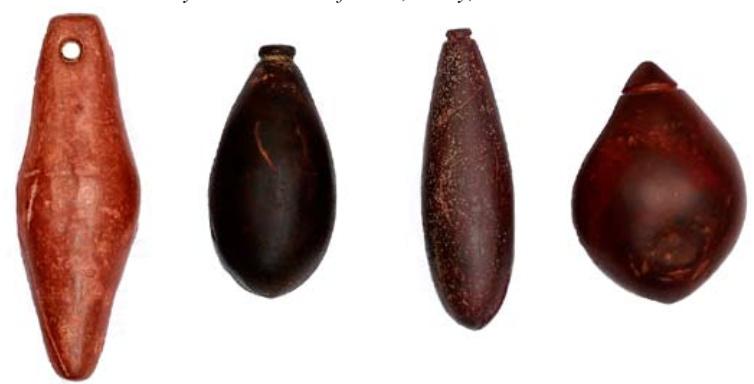
by Korhan B. Raif M.D. Barry, Illinois
Central States Archaeological Societies 2017 April Journal
The four plummets illustrated were all found around New Canton in Pike County, Illinois. They are a good representation of plummet types from the lower Illinois River Valley area. Until I found my first “plumbob” I had always typed plummets as drilled and grooved and had not given them much though other than they were very artistic and enigmatic objects. After finding my first plummet and comparing to others in my collection, I noticed there was more than reached the casual eye and that there were more variations in the grooved type than I had previously appreciated. When doing a little research, I found an excellent article and the best description of plummet types by Gregory Perino and by Ben Thompson in the Central States Archaeological Journal.1,2The plummets are pictured (Fig. 1) in chronological order (left to right) from the Late Archaic to the Late Woodland period. The first is a Godar type drilled plummet. It was found by D. Hougland in New Canton, Illinois. It is made of colorful red hematite and measures 3 x 1inches. Most plummets measure between two to four inches in length. Godar plummets have a “coffin” shape and tend to be wider at the top, evenly tapered and rounded at the bottom. It has a drilled top unlike other types of plummets, which are grooved. This is the oldest type plummet and it was originally described on the Godar farm in Calhoun Co, Illinois. It was found with Late Archaic Godar points, but was also found in Middle Woodland (Hopewell) context on the Snyder site, also in Calhoun County. Calhoun County is just south of Pike County, and both counties are nestled between the Mississippi and Illinois rivers. The second plummet is an Elm Point type plummet. It is a personal find, made of hematite, also from New Canton. It was found on a sand ridge in the Mississippi bottoms, on a site that I have found Late Archaic corner notched and Hopewell Snyder points. This type was first described from a bluff site overlooking the Mississippi flood plain in Elm Point, St Charles, Missouri in an Archaic context. This would be south-west of Calhoun County where the Snyder and Godar sites are located on the opposite side of the Mississippi River. The Elm Point type has an expanded mushroom or button like top that is wider than the stem. The stem may be extended or short. It is heavier in the bottom half and has a rounded to pointed lower end. Some have a more globular form with the expanded button top like the one illustrated. 1The third pictured is a hematite Gilcrease grooved plummet also found by D. Hougland in New Canton. Like most plummets it is made of hematite. Along with the Elm Point, the Gilcrease Grooved types are the least common types. Plummets are most made of hematite, but have also been made of limestone, granite, quartz, slate, shell and copper. Perino considered the Gilcrease Grooved a specialized form. It has a well-made groove close to the truncated top which has beveled or rounded edge. The stem is straight or convex-sided. Its body is heavier in the lower half with a tear drop shape and rounded at the bottom. The original Gilcrease Grooved plummets were found in a bluff top Hopewell mound group overlooking the Illinois River in Kampsville, Calhoun County, Illinois. Although the Elm Point and Gilcrease Grooved may look similar, if one looks at the picture one can see the more expanded pronounced top of the Elm Point type. The last is the Snyder grooved plummet. It was found by G. Harrison north of New Canton. It is made of a reddish hematite, and was found on a sand ridge that produces Late Woodland and Snyder points. This is the most common type of plummet found in the lower Illinois valley. This type is widest and heaviest at the bottom, the sides are always convex, and the stem is thick and tapers to a slightly flattened or rounded top. The groove is found lower on the stem compared to the other grooved types and the top is larger and has a pyramid like appearance. The Snyder Grooved was originally found on the Snyder site in Calhoun County, Illinois and is believed to be attributed to the Hopewell and Late Woodland period. 1,3New Canton is located along the base of the bluff in the Mississippi bottom in west central Illinois County. The bluff tops have produced many fine Early Archaic points and the bottoms have many Snyder, Woodland and some Mississippian sites. The famous Pulliam axe was found in New Canton and the giant Atlas Spear was found south of the town. For further reading on plummets I would strongly recommend the article by Greg Perrino in the CSAJ.11. Tentative Classifications of Plummets in the Lower Illinois River Valley, Gregory Perino, CSAJ October 1986.2. Plummets, Ben Thompson, CSAJ April 1975.3. Editor’s note: Plummets have never been found in direct context in anything but Archaic settings. Gregory Perino found the Gilcrease plummets beneath the Hopewell mound mentioned, in an Archaic component. The Snyder site is more known for its Hopewell component, but it had underlying Early Woodland and Archaic components besides (which the Snyder plummets are associated with). Personal communication with Ray Fraser February 2017The Central States Archaeological society is looking for new members here is a link to sign up. Its only $27.00 you get four journals per calendar year. HTTPs://csasi.org/subscribe_quick.htm
